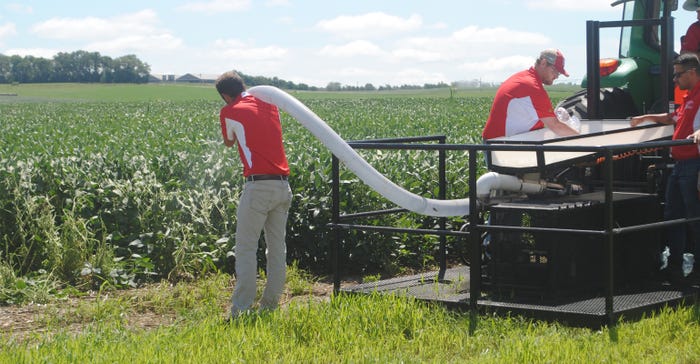
It’s hail season in Nebraska and across the Plains states. The largest hailstone ever measured in the U.S. was 8 inches in diameter, and fell in Vivian, S.D., on July 23, 2010. This massive hailstone was also the heaviest in the U.S., weighing in at 1.94 pounds.
It doesn’t take a 2-pound hailstone to do a lot of damage to your corn crop, and hail is a common problem during the growing season — with 70% of hail events striking Nebraska from May to July, and 30% coming in June alone.
Justin McMechan, Nebraska Extension crop protection and cropping system specialist, has been studying the effect of hail on crops, even employing a “hail machine” to simulate the damage that a hailstorm can inflict in the field.
Give it time
“One of the critical points when hail strikes is to give the crop enough time to respond,” McMechan says. “Many crop adjusters won’t come out to the field until seven to 10 days later” for that reason.
After as little as three to four days, the corn crop often begins to recover. By the seventh day, there can be signs of regrowth, and many times, the plants can regrow quite well, McMechan says.
The early and vegetative stages are crucial if hail strikes during this period. “Yield loss at this point is based on remaining plant stand after the event,” McMechan says. “Defoliation losses are not considered until after V5 stage because this is when the growing point of the plant is above the soil surface.”
The opportunity and urge to replant is one reason this stage is so important. “Corn is fairly resilient to hail damage early in the season,” he says.

BRINGING HAIL: A hail machine is used by researchers such as Justin McMechan, Nebraska Extension crop protection and cropping system specialist, to help understand the effect of hail on Nebraska crops.
While it is rare to replant corn in July because it is so late in the season, and producers need to consider frost risk to the crop in the fall, there are situations where it can still be a viable option, McMechan says.
“There is no point where we really want to see hail, but the stage around R1, silking and tassel is where we can see significant yield losses from hail because the leaf area is 100% exposed, and you can lose your pollination source,” he says.
During the later reproductive stages on through physiological maturity, direct kernel loss can be the reason for yield losses.
“Stalk damage in the later stages can be a concern for growers, and there is no way to evaluate stalk damage as far as yield loss,” McMechan says.
McMechan suggests trying a pinch test of stalk damage by standing next to a corn plant and extending an arm outward.
“If the plant breaks off and falls over, you will want to do the same test on 100 plants in the field to gain some estimation of overall damage,” he explains. “If the damage is 60% to 70%, you may want to prioritize this field for harvest first.”
Tattered leaves
Tattered leaves can be visually disturbing right after a hail event, but the plants are quite resilient from even devastating leaf area losses.
“Defoliation levels of 25% of the leaf area cause yield losses during VT stage for instance,” but not as much as producers might think, McMechan says. “Tattered green leaves may not be destroyed, so we need to wait because leaves may still be connected, but the tissue may be destroyed. Even if it is tattered, if it is still green, it counts to the green, nondead portion of the evaluation.”
While yield losses are much greater with 75% defoliation levels, the crop may still produce some grain. By V10, if the field loses all of its leaves to defoliation, replanting probably will not recover a lot of that yield.
“This is another reason that it is important to wait, because you could still have a viable crop,” McMechan says. “You need to do the proper evaluation.”
If hail occurs after R1, disease issues can be of concern. “Fungi that get into the plants usually come in through sap beetles that are attracted to damaged plants,” McMechan says. “They come from the soil, and bring fungi with them into the plant. The pathogen creates imbalance in hormones. Seeds can germinate in the ear, and there are increased losses with this.”
He suggests cutting these crops for silage, or take the crop to harvest, but dry it quickly in the bin to get the moisture down to 13% to 14% to stop fungi from reproducing.
Fungicide applications after hail are a common practice, but McMechan points to a recent University of Nebraska study that documented disease severity three weeks after a hail event on corn that had fungicide applied and plants that had no treatment.
“Foliar fungicides did not provide yield benefit to either the hail-damaged corn plots or the nondamaged corn,” he says. “So, disease risk should be considered when making fungicide applications.”
Learn more about how to evaluate corn crop damage after hail and steps you can take after a hail event by visiting cropwatch.unl.edu/hailknow.
About the Author(s)
You May Also Like






